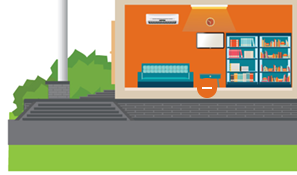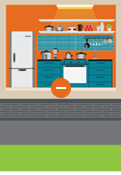Attic, Garage and Insulation
Your attic, garage and basement are the main areas where insulation can improve your home’s energy efficiency. Look below for helpful tips to reduce the electricity bill by properly insulating these areas.
Office and Electronics
In this digital age, electronics are found in every room of the house and many of them have energy-efficient settings. Check out our list below for more information.
Bedroom
Even while you sleep, your home can still use energy. Below we have outlined some tips on saving electricity and staying comfortable without breaking the bank.
Bathroom
This may not be a hot spot for energy efficiency, but there are ways to conserve energy without sacrificing comfort. Check those out below.
Living Room
From lighting to windows to your thermostat, the living room is a great place to make the most out of home energy savings. Read on to see how to reduce electricity bills in your main living space.
Miscellaneous
There are many more ways you can save energy that don’t necessarily fit into one particular room. We have you covered with more tips below.
Kitchen
Even with energy-efficient appliances, you can still learn how to save money on electric bills with the helpful tips you’ll find below.
HVAC – Heating, Ventilation and Air Conditioning
The majority of your energy usage comes from your HVAC system. Below we have outlined numerous tips to help you stay comfortable and maintain your system while lowering your utility bills.
Health and Safety is a very important aspect to consider and be mindful of in your home. Below is information to consider to help keep your indoor air clean and your family safe. Watch our webinar on Health and Safety for an Introduction to Health and Safety.
MOISTURE
- Water can lead to building deterioration by biological pests. These pests also create a threat to human respiratory health.
- Water corrodes metal, dissolves glue, warps wood, and weakens mortar.
- Water can reduce the thermal resistance (i.e. ability to slow the transfer of heat) of insulation and can permanently damage it. This can also lead to mold growth depending on the temperature of the area.
- Water vapor movement via air leakage primarily occurs when heating/cooling systems are running.
- Air leaking in the winter time can carry moist indoor air through the home to the outdoors, leading dryer indoor air.
- Air leaking in the summer does the opposite, it brings moist warm air into the home, increasing the home’s humidity.
INDOOR AIR QUALITY
By-products from combustion appliances and environmental tobacco smoke are the biggest contributors to indoor air pollution such as carbon monoxide, nitrogen oxides, volatile organic compounds [VOC] and fine dust particles.
- Gas dryer, fireplace, range, furnace, water heater, automobile, unvented combustion space heaters and vented combustion space heaters.
- Unvented space heaters and gas ranges release all their combustion by-products into the indoor air.
- Vented space heaters may spill their gases temporarily or continuously while they are operating. This is called backdrafting.
- A wood stove’s combustion by-product is particularly dangerous. Smoke from wood contains numerous toxins in high concentrations.
- Carbon Monoxide (CO) is a by-product of incomplete combustion from a gas furnace. Since electric/resistance furnaces do not burn (combust) anything, there is no process of combustion.
- Higher concentrations of CO are 50-3,000 parts per million (ppm), and can lead to severe headaches, vomiting and potentially death.
- Lower concentrations of CO (causing sickness) are 5-50 ppm, have symptoms similar to the flu and often go unnoticed.
- EPA's suggested max exposure to CO is 8 hours at 9 ppm in room air.
- These levels can come from malfunctioning combustion appliances (e.g. unvented combustion space heaters, gas ranges, leaky wood stoves and backdrafting of vented space heaters).
- Backdrafting in furnaces and boilers may also lead to high levels of CO.
- Carbon Monoxide (CO) can also be caused by flame interference from a part of the heating device (pan over a gas burner on a range top), flame interference from dirt and debris, the misalignment of the burner or inadequate combustion air.
- Cracked heat exchanger in a gas furnace.
- Improperly installed or a faulty design of appliance venting (water heaters, gas furnaces, etc.)
- A depressurized zone near a furnace, water heater or room heater from exhaust fans, clothes dryer vents and chimneys can all depressurize this combustion zone.
- Common sources of VOCs are household products like aerosol sprays, preservatives in wood, air fresheners, paints, strippers and other solvents.
- Other sources of VOCs include building materials, varnishes, office equipment (copiers, printers), adhesives and permanent markers.
- Nitrogen oxides are created naturally by the combustion of hydrocarbons in air and can come from all combustion motor vehicles (i.e. cars, trucks, trains, etc.).
- In healthy adults, nitrogen oxides cause impaired respiratory function at 2 ppm and sometimes less.
- Wood stoves, unvented kerosene space heaters and cigarette smoke release fine hydrocarbon dust and VOCs into indoor air.
- Radon gas is a naturally-occurring radioactive inert gas that is colorless and odorless. (per the EPA)
- Per the Environmental Protection Agency (EPA), any home with a radon concentration above 4 pico-Curies per liter (pC/L) of air should be mitigated (see Mitigation below).
- Dust from construction and other activities can increase radon's danger. The dust acts a transport mechanism for radon carrying it into the lungs.
- For more information on Radon by the EPA, please visit: https://www.epa.gov/radiation/what-radon-gas-it-dangerous
MITIGATION (What to do)
- Carbon Monoxide meters measure the CO in the surrounding air and have a variety of features depending on the model.
- Air quality monitors measure the levels of CO, formaldehyde, VOCs and more in the surrounding air. Some are even smart technology-capable.
- Carbon Monoxide detectors come in plug-in varieties with a battery backup. There are even wireless versions for testing at the source.
- Testing for radon gas can be done by your local Health Department or a private radon mitigation consultant.
- Provide plenty of fresh air to the area you are using VOC products.
- Use or exceed the precautions on the label of the product.
- Never mix any VOC product with another unless directed to do so on the label.
- Bi-annual inspection of your heating/cooling system should be completed by a licensed and bonded HVAC contractor.
- Smoke alarm should be installed nearby the heating/cooling system.
- High limit control should work properly on your furnace and more (all can be verified with an inspection).
- Bath fans and kitchen exhaust fans are designed to pull air and the chemicals that may be present in it up through the fan and out of the home. It is highly recommended that a kitchen exhaust fan be installed above the stove and used when cooking.
- Having your heating/cooling system inspected by a licensed and bonded HVAC contractor will ensure the combustion safety in your home.
- A home energy audit will also help identify any potential issues with moisture, combustion safety and more in the home. An audit can provide a full report of your home’s performance, and measures to take, to not only ensure its efficiency but also its safety.
- To find a local energy rater, please visit:


















